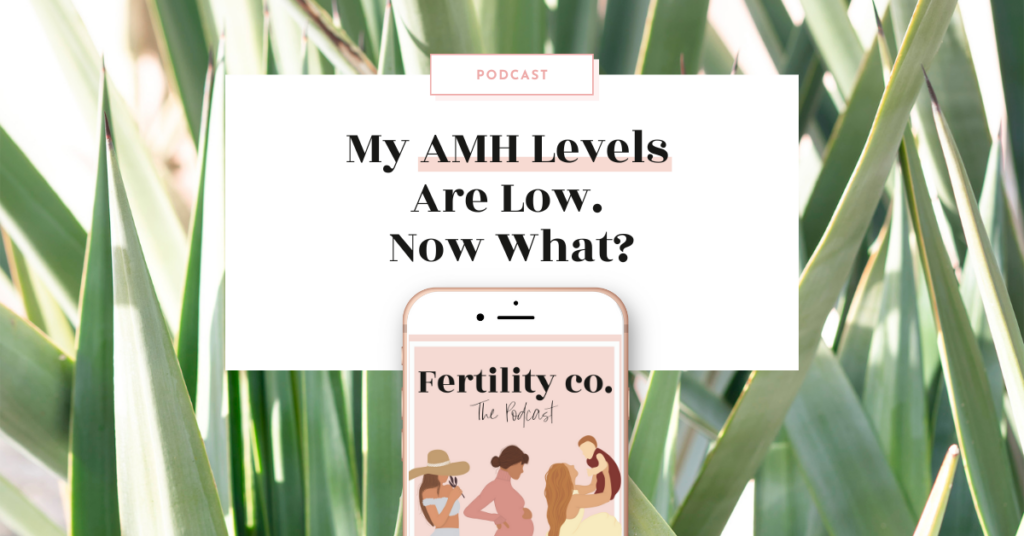
Ever heard the advice that low AMH levels mean you’ll never get pregnant naturally?
Well, I have some thoughts… (drumroll please)
Quality over quantity. Always.
And why do I believe this, even though others may have a different opinion or take on things? That AMH levels are everything when it comes to your fertility?
It’s because while AMH levels are a pretty reliable indicator of your ovarian reserve (how many eggs remaining in your ovaries with “reproductive potential”)… AMH levels give no insight into the quality of those remaining eggs.
Sure, the more eggs we have the better, because this gives us an indication of time frames for conceiving and when we might enter perimenopause, but when you’re trying to conceive, we want as many good quality eggs as possible.
LISTEN ON: APPLE PODCASTS | SPOTIFY
HERE’S WHAT WE COVER
- What AMH levels actually mean (and how accurate are they?)
- Ovarian reserve and AMH testing
- When to test your AMH levels
- Why your levels might be low
- Can you increase AMH levels? What to do if you’ve been told your AMH levels are low
EPISODE NOTES
What AMH levels actually mean (and how accurate are they?)
Ovarian reserve
Ovarian reserve refers to the number of viable eggs that are left in a woman’s ovaries. Eggs with reproductive potential, the potential to be fertilised and develop into a baby. Unlike men, who produce sperm throughout their adult life, women are born with all the eggs they will ever have in their lifetime, and the quality of these eggs will gradually decline as she becomes older. By the age of about 35, this quality will begin to decline more rapidly, which is why this is around the age that we start to think about our body clocks and all of those fun things.
Anti-Mullerian Hormone (AMH)
Inside our ovaries we have follicles which contain the eggs that will develop and mature at ovulation. These follicles produce a hormone called Anti-Mullerian Hormone (AMH) and so the amount of AMH present gives an indication of the number of eggs in the follicle; our ovarian reserve.
The level of AMH in a woman’s blood is a pretty reliable indicator of her ovarian reserve. The amount of AMH remains pretty constant until early adulthood and will start to decline from about age 25, a little more rapidly from about 35 and it will continue to decline until it reaches zero at menopause. So AMH declines, which in turn causes egg quality to decline with age.
AMH Testing
AMH testing, also called the egg-timer test, is a blood test and it can be done any time throughout the menstrual cycle, so it’s not dependent on what phase of the cycle you’re in like a lot of other hormone testing. It’s usually done combined with an antral follicle count via ultrasound to predict ovarian reserve. There are mixed opinions about whether oral contraceptives have an effect on AMH levels, particularly if you are not having monthly breaks with sugar pills, but rather taking the hormone pill continuously. Something to keep in mind if you’re testing while on contraception or after long-term use.
You can ask your GP or a fertility specialist for a referral for testing. In Australia, testing is not currently covered by Medicare and it will set you back about $100. You should receive your results within about a week.
Your results will be interpreted by comparing your levels to the levels of other women of the same age. A low AMH level for your age could be a possible sign of early menopause, while an abnormally high AMH level might indicate PCOS. Like any blood test, there are normal ranges. But of course, normal to one practitioner may not necessarily be normal to another. You may be right on the cut-off of the lower end of normal and be told everything is fine, while another woman may also be at the cut-off but at the upper end of “low”. So even though the two results are almost identical, one woman is being told her levels are too low, while the other is told she is fine and within normal range. So this is why you want actual numerical values, not just “high, normal or low” so you can get a better idea of where you sit.
Another limitation of AMH testing that I mentioned earlier is that although it can give you an insight into your remaining quantity of eggs and therefore the number of fertile years you have left, it does not give you any information about the quality of those remaining eggs. So once again, two women might have similar AMH levels but their chances of conceiving are actually very different because one has good quality eggs and the other does not.
When to test your AMH levels
There are two key reasons why you would get AMH levels tested. Firstly, to determine your fertility status, and secondly to look at your response to fertility medication if you have started the process of assisted reproduction.
If you are under 35, you might choose to be tested to check your ovarian reserve and your fertility status so that you can decide when to start a family. If you have been trying to conceive for more than six months, you might choose to test to make sure your ovarian reserve is appropriate for your age. It can also be helpful if you are at a high risk of reduced ovarian reserve, for any number of reasons like a history of ovarian failure, family history of early onset menopause, auto-immune disease or if you have had chemotherapy or ovarian or endometrial surgery in the past. It is also very useful for women with a diagnosis of PCOS or polycystic ovaries.
For those women who have started fertility treatment, AMH testing can predict your ovaries’ response to fertility medications. Unfortunately we can’t increase AMH levels but if we know AMH are extremely low, then you may receive a higher dose of fertility medication. If you haven’t started treatment yet, but you’re considering whether to take this line of action to help you to conceive, it’s useful information to have because low AMH levels might indicate a possible poor response to treatment, compared to higher levels. It will give an indication as to how many eggs can be retrieved in an IVF cycle, and with women freezing their eggs getting more and more common, AMH levels can help you to determine how many eggs you’ll be likely to freeze in one cycle.
With that said, low or high levels are not the only indication of pregnancy success. This is testing your ovarian reserve, the quantity of eggs you have, and it’s not a measure of your fertility. Like I’ve said already, quality over quantity. If you undergo testing and receive a normal result, but you’re still having trouble getting pregnant, then egg quality might be a contributing factor. This isn’t necessarily a bad thing, because we can’t change our AMH levels but we can improve the quality of our eggs with some pretty simple lifestyle changes.
Why your levels might be low
AMH levels might be low and you might consider testing for those situations I’ve talked about where ovarian reserve may be low or have been diminished for many different reasons – age, endometriosis, PCOS, genetic factors, auto-immune disease, chemotherapy or surgery.
Other factors that can contribute to low AMH levels are, you guessed it, lifestyle factors. Smoking, environmental pollutants, obesity. While one of the biggest causes is older age, which we can’t control, we can control these lifestyle factors. And remember we can’t increase our AMH levels, so this needs to start when we are younger, before we even think about starting a family. It’s those positive behaviours we implement early to avoid the cumulative effects of negative behaviours later. If you do have low AMH levels however, it’s not all doom and gloom because you can improve the quality of your eggs and this is also through these modifiable lifestyle factors.
Let me make it very clear that AMH testing is not the holy grail of fertility testing. It’s just one piece of the overall fertility puzzle. It’s not a test of whether or not you can get pregnant naturally. And that’s because it doesn’t tell us about the quality of your eggs. There’s no test unfortunately for egg quality, but we do know that it declines with age in a pretty predictable way. And we do know that lifestyle modifications, diet, exercise, sleep, stress management and avoiding environmental pollutants and hormone disruptors all impact egg quality in a positive way. AMH testing also can’t tell you if you have fibroids, uterine scarring, endometriosis, PCOS or any other condition that makes it more difficult to conceive. It’s a snapshot of your levels at one particular point in time.
It’s completely understandable that after having this test, you want to know if your AMH levels are normal for your age, whether they are higher or lower than average. But what’s average anyway, really? Average ranges can only be determined from the pool of data we have available, so there’s a high possibility that this data pool is skewed because women conceiving easily aren’t getting their levels tested in the first place. So rather than having your results compared to an entire population of women without fertility issues, you’re being compared to past averages based on a population of women who have been tested after having trouble conceiving. So the results could likely be very different. So take your results with a grain of salt and consider how you can optimise the quality of your eggs before falling into a downward spiral of despair because you’ve been told your levels are low.
Can you increase AMH levels? What to do if you’ve been told your AMH levels are low
If your results indicate that your AMH levels are lower than expected for your age, you’ll likely be referred to a fertility specialist for further testing and discussion of next steps. It is really important to point out here that women with low ovarian reserves and women with high ovarian reserves get pregnant at exactly the same rate. Meaning, regardless of your ovarian reserve, your chances of conceiving do not change. Why? Because both groups of women release one egg per month at ovulation. One group might have more remaining, but having higher ovarian reserve and therefore higher AMH levels doesn’t mean you release more than one egg at ovulation. In this case, how do we work out which woman is more likely to conceive? By the quality of the eggs she does have!
There is no specific treatment for low AMH, so the focus will therefore be on improving the quality of your remaining eggs. This is done through lifestyle management – diet, exercise, sleep, stress and environmental factors. Supplementation with Vitamin D, co-enzyme Q 10, folic acid and fish oil have been associated with positive outcomes for women with low AMH levels. Again, the goal isn’t to increase levels, it’s to optimise the quality of the remaining eggs to maximise chances of conception. This allows you to ensure you have explored all conservative options first, but having this test and knowing what you’re working with is useful is that it gives you advanced warning that your ovarian reserve is declining, so if you are in your mid to late thirties, this is likely going to be your prompt to explore your reproductive options sooner rather than later.
So if you’re feeling deflated because you’ve been told your AMH levels are too low to conceive naturally, remember that quality is more important than quantity.
Are you dealing with low AMH levels? Does this reframe help you or do you still have questions? Let me know – I’d love to help.

+ show Comments
- Hide Comments
add a comment